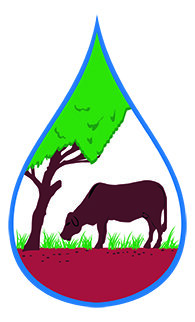Home of my heart
Ernest and Robyn Bassingwaighte’s departure from Toomba Station is bittersweet.
For generations, the Bassingthwaightes have interspersed their commercial horse and cattle operations on the Charters Towers property with the preservation of a unique sanctuary of native flora and fauna. And now it is time to hand the responsibility to new custodians.
One of the unique wetland ‘pockets’ on Toomba, Charters Towers.
Ernest’s grandfather E.E.D. White purchased Toomba in 1904 to operate as an outstation to Bluff Downs, which the family had purchased from the Hann family in 1872.
He says the unique landscape and native wildlife was evident from the start and always a priority for the family to preserve.
“My grandfather had Toomba declared a fauna sanctuary in 1912. And as far as I am aware that was only the second one in Queensland at the time,” says Ernest.
The sanctuary includes an area within the Basalt Wall; a 13,000-year-old lava flow- the youngest in Australia and the second longest lava flow in the world. On Toomba, it borders almost 26 square kilometres of spring fed wetlands. Locals refer to them as ‘the pockets’. Long Pocket is a drowned lava lake, north of the Toomba house. The open area originally filled with lava, but one end breached, collapsing the surface and becoming the equivalent of a shallow lake for many millennia. Eventually it filled up with diatomaceous earth- which is a soil formed by the skeletons of algae and has a capillary action within it so the water spreads underneath and creates a perpetually green pasture.
Ernest’s family had always employed a manager for Toomba, opting to manage their southern properties, where Ernest grew up. He admits to finishing school interested in biology, but without drive to do anything with it. His father suggested studying accounting as it would at least be useful.
“I finished at UQ in 1965. Toomba was having one of its perennial labour problems, and was looking to work as a ringer, so I came up and never left!”
But of course, there was a social side to Ernest’s new adventure and while attending the Mingela Races he met a young teacher- Robyn Broughton.
Originally hailing from Charleville, Robyn’s parents drew Taemas, south of Charters Towers and she followed when her teaching study was complete.
They were married in 1970 and so began Robyn’s second love affair- Toomba.
“I had never been to Toomba before we were married. I was just blown away. It is the most extraordinary place,” she says.
““I think the country is just so unique that everyone who comes here can feel an attachment to it. I love the birds- there’s 206 species and so many of them are so rare. They’re here because of the unusual landscape- some of them we’ve only seen twice.” ”
Robyn immediately focussed on the homestead while Ernest focussed on the cattle. For those years he says he spent most of the year either on a horse or shoeing it and eventually he started looking more at the country.
The property was broken up into excessively big paddocks with consolidated breeder herds that moved into the wetlands when the drier country really started drying out. They stayed in the wetlands for six months and were taken back to the dry country before the wet season hit, albeit in excellent condition. Ernest said it meant the dry country got a long spell, but not at the right time of the year.
“We really needed to look at how we could manage our country better,” says Ernest.
“We’d already started some riparian fencing on Lolworth Creek, mainly because of our conservation agreement with National Parks and the results were dramatic in a short period of time.”
Along with many of their neighbours, the Bassingwaighte’s first taste of the Landcare concept was when John Howard’s National Heritage Trust program was launched.
With generous government funding available, a sub-branch of the Dalrymple Landcare Committee (DLC) was formed- the Birdbush Basalt Landcare Group- and they fenced off as much of their Lolworth Creek frontage as possible.
At the height of the National Heritage program, there were 22 sub-groups of the DLC, with landowners spurred to commit large ‘in kind’ contributions to match the funding after seeing promising results on their neighbours’ properties.
“The banks were stabilised, and we had good feed for the dry. It benefited a lot of people,” Ernest said.
“But the funding ran out and we had a lot of bad drought years, so a lot of the groups disbanded.”
“For the Birdbush Group, our next step was doing a Grazing for Profit school together which gave us another way of thinking of how to progress our success. We fenced up more country, improved our waters, and increased spelling.”
Ernest went on to serve 11 years as DLC’s treasurer, citing his original experience with Landcare as having changed his whole attitude to pasture and grazing management.
But, as much as the couple’s connection to their property is deep rooted, so is their commitment to their family; hence the bittersweet.
“When our two boys decided they didn’t want to come home, sooner or later we had to move,” says Robyn.
“We decided to sell by tender to ensure, as far as you can, that the management and the nature conservation continues. We were looking for people who would love this country, not just for cattle production but its intrinsic value- and I think we’ve found that with the Heading Family.
Robyn and Ernest Bassingthwaighte.


